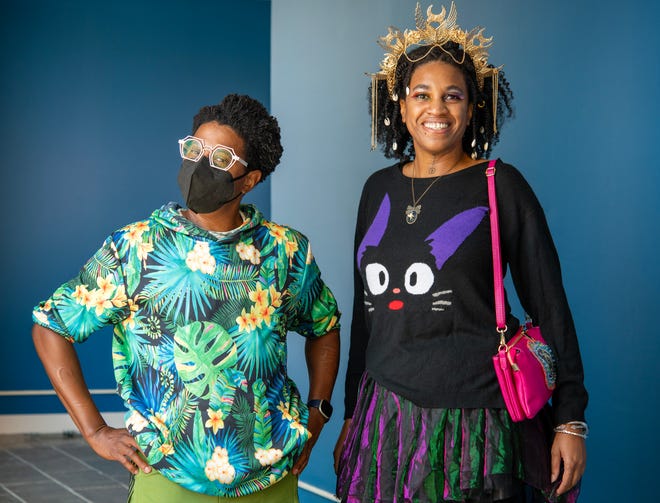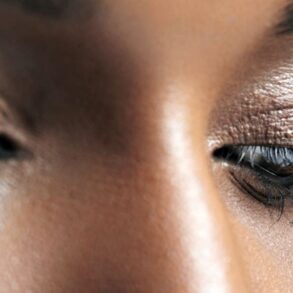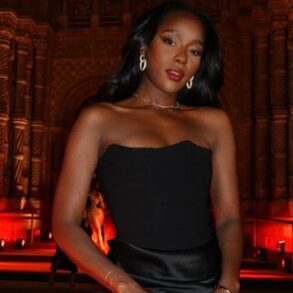
A new exhibition at Fitchburg Art Museum highlights the enduring influence of Africa on contemporary Black artists.
The exhibition highlights a yearlong creative collaboration between the Boston-based artists’ collective WHERE ARE ALL THE BLACK PEOPLE AT and emerging artists working together in Fitchburg Art Museum’s inaugural Black Artist Residency program.
The residency offered WAATBPA founder Archy LaSalle and associate members Lou Jones, Reginald Jackson and Sharon Dunn the chance to collaborate with talented young artists bashexo, Digi Chivetta and George Annan by serving as mentors in a museum-supported setting.
The program gave the seven artists unfettered access to the museum’s permanent collection for inspiration, including its African art collection. The resulting exhibition, “Dialogues, Diasporas, and Detours Through Africa,” was organized by multidisciplinary artist, writer and curator Dell Marie Hamilton in collaboration with FAM’s curator Lauren Szumita. (Szumita has since decamped to the College of the Holy Cross, where she will serve as director of the Cantor Gallery.)

A complex and multilayered conversation
The exhibition opened Oct. 14 and runs through Jan. 14. Hamilton said that by drawing on FAM’s African art collection, the artists engaged with both contemporary and historical aspects of the continent, resulting in work that reflects a complex and multilayered conversation.
“Dialogues, Diasporas, and Detours through Africa” is organized into three rooms: the dialogues room, the diasporas room and the detours room. Each room features the work of different artists who explore various themes related to Africa and its diaspora.

“In my research as a curator and artist, I’ve found there’s been a very long conversation of Black Americans in dialogue with the (African) continent that goes back to the late 19th century,” Hamilton said. She sees a connection between the work of WAATBPA and other contemporary Black artists and earlier examples of Black cultural production such as the work of Edmonia Lewis, who gained international recognition for her 1876 sculpture “The Death of Cleopatra,” and the robust cultural revival of the Harlem Renaissance.
“There has been this artistic engagement in terms of American artists speaking back to the continent,” Hamilton said. “And we could also connect that to the Harlem Renaissance with Countee Cullen’s poem ‘Heritage,’ where the first line of the poem is, ‘What is Africa to me?’ Our contemporary understandings of Africa continue to inspire and influence the work of Black artists today.”

Exploring connections
The artists in the exhibition use a variety of media to express their connection to Africa. Lou Jones, a noted photographer, captures contemporary Black Africa through his ongoing project called the panAfricaproject, which aims to redefine the modern image of Africa. His images will be paired with video-based works and flags. Sharon Dunn’s art is digital-based and explores themes of metamorphosis, transformation, mortality and aging. bashexo’s work is installation-based and incorporates materials, costumes, dance and masquerade. It includes beautiful fabrics, handmade dolls, a baby carriage and a soundscape.
As inspiration, bashexo chose a messenger mask and costume by Felix Edeh, a contemporary artist from Nigeria. The uses of masks and costumes vary among African cultures and often connote a transmigration into a spirit, animal or natural force. Traditionally, the masqueraders were men with very few cultures allowing women to participate.

In bashexo’s installation, that traditional gender limitation is supplanted by a focus on importance of honoring Black trans femmes and Black women who have disappeared or been murdered and remain unaccounted for. bashexo identifies as a transdisciplinary artist working with textiles, soft sculpture, installation and performance art. “In addition to my focus on tending to the spirits of those who have crossed over, particularly those who have left too soon through traumatic experiences, the installation also pays homage to my mother and aunts who taught me so much about textiles,” the artist said.
George Annan, a Worcester native and 2021 graduate of Worcester State University, has enjoyed wide success as a commercial photographer, producing work for high-profile corporations including Converse, Puma, and Tito’s Vodka. He said he was “over the moon” when he was selected for participation in the museum residency program, which represented a new challenge and a big change from his commercial work.
“I didn’t really have much museum experience prior to this, so I was completely out of my element,” he said. “But they were so kind and nurturing to me, and any time that we’d have in-person meetings or Zoom calls, or any time I needed advice, the whole team at Fitchburg Art Museum was totally supportive of me.”

‘Quite a learning experience’
It wasn’t just the museum experience that was new to Annan. The exhibition will include “From Seeds to Plates,” a series of 15 photos he took at a community garden in Worcester. “I grew up in the city and had absolutely no prior experience or knowledge about agriculture, so it was quite a learning experience for me,” he said.
Digi Chivetta, a Fitchburg multimedia artist and writer with a background in fashion design, says she relates to the continent of Africa through her spirituality and the cultural complexities of being Black and part of the diaspora. Her work arises from her ancestral identity as a Griot, the traditional West African storytellers and keepers of the historical record.

Her roots are reflected in her current project, which includes a collage of journal pages inspired by her reflections on Orishas, the deities of the Yoruba religion of Nigeria. Her art exemplifies one of the underlying themes of the exhibition — that many artists, even generations removed from Africa, feel a distant but persistent call to the continent.
“I’ve always been really spiritual, even when I was a child,” Chivetta said. “I wrote a book when I was 10 years old, and I found a copy of it 20 years later. It’s a story about a boy who dies in a fire, wakes up in a land of candy, and then has to pass three tests to make it to the afterlife.” It wasn’t until she grew up that she realized the story reflected Griot beliefs that she was not consciously aware of at the time. The land of candy represents the heavenly family and the afterlife, which requires passing tests for entrance, she said.
The main character, a little boy with curly red hair, reflects one of Chivetta’s Irish ancestors, which she didn’t know about at the time of writing the book. She believes that discovery added a layer of significance and authenticity to the story, as it aligns with her genetic makeup. “The book speaks to my DNA and spiritual connection, and the resonance of these ancestral stories through time,” she said. The book will be on display in the Learning Lounge at FAM during the exhibition’s run.

Choosing symbols
The show aims to support and inspire creativity and learning by showcasing the work of contemporary New England artists in conversation with FAM’s permanent collection. Objects from the collection were selected by Jean Borgatti, FAM’s consulting curator of African, Oceanic and Native American art. Borgatti had been asked to choose items that related to the participating artists’ areas of interest, so for Annan’s agricultural project, for example, she chose a mortar and pestle and a ladle symbolizing generosity and the role of women in food preparation.
A ceremonial sword from the Ashanti people of Ghana also is on display with other permanent-collection objects that the artists used for inspiration. The tall, elaborately carved sword brought respect but also obligation to the elder upon whom it was bestowed. In Ashanti lore, that delicate balance of power is symbolized by a hand holding an egg, Borgatti said.
“The proverb associated with that imagery suggests that power should be held neither too tightly nor too loosely,” Borgatti said. “If held too tightly, it may be broken and lost. If held too loosely, it may be dropped and lost. The idea is to maintain an appropriate balance, which includes being fair, just and honest in wielding power.”

Creating opportunities
The residency program specifically focuses on providing opportunities for Black artists who traditionally have not had the same opportunities as others, Szumita said. The museum also recognizes diversity in the Fitchburg and aims to increase access and provide platforms for diverse artists.
“Part of our mission is contributing to the well-being of our diverse communities,” Szumita said of Fitchburg, a Gateway City. “We are located in a city with a lot of Spanish speakers as well as a lot of racial diversity and people of various ethnic backgrounds and gender identities, so we’re always looking to promote that and provide platforms for artists that help lift up diverse voices.”

One of the ways the exhibition speaks to that mission is by supporting contemporary artists and putting them in direct conversation with the museum’s collection, she said. “We’re about inspiring creativity and learning, so we’re providing an opportunity for artists to create work and then, by putting all of that on display, hopefully our audiences, the public, will think of African art and the art of the African diaspora as being very much alive and not something that was in the past.”
The concept of African art as dynamic and evolving is an especially important one to WAATCP founder LaSalle, who bristles at the many exhibitions that limit Black and brown artists to Black History Month or to work that only reflects historical culture.
“This show addresses it in a fresher way,” LaSalle said. “Yes, it’s about Black people and the Black artist residency, but the work that’s being produced is really fresh and unique. There are some of the more typical things as well, but when it comes to Black and brown artists, I would say this show stretches the canvas a little bit and it really makes for some positive changes.”
About the Artists
George Annan: George Annan is a Ghanaian American photographer from Worcester who is residing in Greater Boston. Annan specializes in editorial and commercial portraiture in addition to photojournalism. His work is inspired by the ever-changing lives of people as his creative practice is rooted to the city and to the fondest memories of his subjects. Annan has had his work featured on “Good Morning America” and his client list includes Converse, The Wall Street Journal, The Boston Globe, Puma, Crocs, Bodega and Harvard University.
bashexo: bashexo is transdisciplinary installation and poetic movement performance practitioner as well as a QTBIPoC (Queer Trans Black Indigenous Person of Color) creative community activist and space|place tender. ze’s work blends race, queer and liberatory theory and roots itself in African diasporic spiritual traditions and aesthetics as a means to explore the queerness of Blackness, the aliveness of liberation, and nourishment of intergenerational/communal/spiritual healing. Common materials in ze’s work include soil, light, textiles, audio/video elements, clay, mesh and wood. These materials and others are assembled/aggregated to create ephemeral (often immersive) third spaces that centralize QTBIPoC bodies, narratives, and practices of beingness and refusal. ze received their B.A. from Lesley University in Cambridge and their MFA from Massachusetts College of Art and Design (MassArt) in Boston.
Digi Chivetta: You’ll often hear Chivetta described as a multidisciplinary artist and writer. In her Yoruba Orisa culture, however, her title is more concise. She is known as a Griot. There was no limit to the media that a Griot can master to bring their ancestors’ stories alive for audiences. More than hereditary, a Griot’s stories are written in their blood. Their DNA is an intricate sigil containing the tracks of their ancestors. Griots are believed to be born to relay messages to the world in a way that only their unique incarnation can. No matter what the Griot’s environment, they’ll have a strong compulsion to tell the stories written in their blood. In May 2020, Chivetta’s work was featured at the Venice International Art Fair in Venice, Italy, and in 2021, she completed a mural for Fitchburg’s Abolitionist Park.
Sharon Dunn: Sharon Haggins Dunn is a mixed-media artist/educator who employs photography, drawing, painting and digital imagery to create temporary site-specific installations, mixed-media environments and virtual immersive landscapes. She explores the concept of sacred space, referencing unknown ancestors, lost histories, forgotten narratives, and rituals of passage. Her work has also been part of exhibitions at the DeCordova Sculpture Park and Museum, Lincoln; the Broad Museum, Los Angeles; and the Tate Modern, London. Dunn is also professor emeritus at Massachusetts College of Art and Design.
Reginald Jackson: Professor emeritus of communications at Simmons University, Reginald L. Jackson, Ph.D., MSW, community worker, visual artist and artist emeritus at Northeastern University’s AAMARP (African American Master Artists in Residence Program) uses photography and graphic arts to illuminate the road he has traveled within African spirituality. Using montage, collage and realism as vehicles, his striking visualizations depict cultural continuities and struggle, while suggesting humanity’s divinity and connectedness to nature. Jackson’s work can be found in collections at Harvard, Yale, MIT, the Library of Congress, and the Smithsonian Institution.
Lou Jones: Lou Jones is a freelance commercial/documentary/art photographer based in Boston. He has emerged from every technological, stylistic and aesthetic transition to remain relevant in image making. He has made the world his studio, photographing on six of seven continents, 61 foreign countries and 48 of 50 U.S. states while on assignment for Fortune 500 companies, publications and magazines, foundations, galleries, and museums. Along the way he has published over a dozen books of photography, taught in schools and colleges, and served on numerous institutional boards of directors. He continues to engage in long-term projects examining tall ships, death row, the Olympic Games, pregnancy and jazz. He is currently in Mozambique capturing images for the exhibition and for his panafricaproject.org.
Archy LaSalle: Archy LaSalle is a fine-art photographer who has a rather unique way of working with a panoramic camera and still uses black-and-white film. Early in his career, he received national and international attention for his artistic documentation of the Orange Line Southwest Corridor Subway project in Boston. In 2021, LaSalle joined the Board of Advisors at the Rose Art Museum at Brandeis University. LaSalle taught photography for over 25 years at Cambridge Rindge and Latin and is the founding director of WHERE ARE ALL THE BLACK PEOPLE AT, a grassroots organization whose mission is to bring attention to and help art institutions rectify past injustices of underrepresenting Black and brown artists in their permanent collections.
This post was originally published on this site be sure to check out more of their content.








